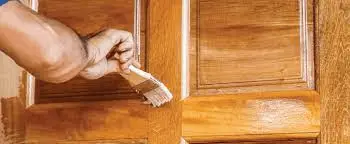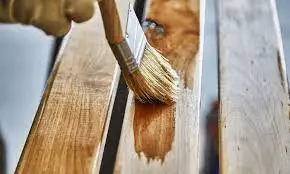When it comes to adding a protective and beautiful finish to woodwork or furniture, lacquer, and varnish are popular options.


In this Lacquer vs Varnish comparison post, we’ll explore the characteristics, uses, and differences between lacquer and varnish to help you make an informed choice for your project.
What Is Lacquer?
Let’s start with lacquer, a finish known for its excellent clarity and fast drying time. Lacquer is typically a clear or colored coating made of dissolved nitrocellulose or acrylic resins in a solvent. It forms a hard and protective film when applied to a surface.
One of the standout features of lacquer is its ability to dry quickly, allowing for faster project completion. This makes it an ideal choice for those who value efficiency.
Lacquer also provides a high-gloss, smooth finish that enhances the natural beauty of the wood or other materials. It is commonly used on furniture, cabinets, musical instruments, and other decorative items.
The advantages of lacquer extend beyond its fast-drying and glossy finish. It offers good durability and resistance to scratches and wear. Lacquer is also relatively easy to repair or refinish if needed.
However, it is worth noting that lacquer may not be the best choice for surfaces exposed to high moisture or heat, as it can be susceptible to damage.
What Is Varnish?
Now let’s turn our attention to varnish, another popular finish that offers a protective coating with a different set of characteristics. Varnish is typically composed of resin, drying oils (such as linseed or tung oil), and solvents. It forms a tough and durable film when applied to surfaces.
Varnish provides a warm and rich finish that enhances the natural color and grain of the wood. It is known for its ability to bring out the depth and beauty of the material. The varnish offers good protection against water, heat, and UV rays, making it suitable for outdoor furniture, boats, and wooden surfaces exposed to the elements.
One of the advantages of varnish is its long-lasting durability and resistance to wear and tear. It forms a hard and protective layer that can withstand heavy use and exposure to various elements.
Varnish is also relatively easy to maintain, typically requiring occasional cleaning and reapplication as needed. However, varnish tends to have a slower drying time compared to lacquer, which can be a consideration for time-sensitive projects.
Differences Between Lacquer & Varnish
Now that we have explored the characteristics of lacquer and varnish individually, let’s delve into their key differences.
Firstly, the chemical composition and drying mechanism differ between lacquer and varnish. Lacquer dries through solvent evaporation, which leads to its fast-drying nature.
On the other hand, varnish dries by oxidation and polymerization, which results in a slower drying time but provides a more robust and durable finish.
In terms of appearance and finish, lacquer typically offers a high-gloss, reflective finish. It provides a smooth and glass-like surface that can be very striking. Varnish, on the other hand, offers a warmer and more natural look. It enhances the wood’s grain and color, providing a rich and traditional finish.
When it comes to durability, varnish tends to be more resilient and offers better protection against water, heat, and UV rays. It forms a thicker and tougher layer, making it ideal for surfaces exposed to heavy use or outdoor conditions. Lacquer, while still durable, may not offer the same level of protection and can be more susceptible to damage from moisture or heat.
Ease of application and maintenance also vary between lacquer and varnish. Lacquer is relatively easy to apply and can be sprayed or brushed onto surfaces. It also allows for easier touch-ups and repairs.
Varnish requires more attention to application technique, as brush strokes can be visible if not applied properly. Maintenance involves periodic cleaning and reapplication, but it is generally straightforward.
Choosing Between Lacquer & Varnish
Now that we have examined the characteristics and differences between lacquer and varnish, how do you decide which one is best for your project? Here are some key factors to consider:
- Desired Finish: Consider the appearance and aesthetics you wish to achieve. If you prefer a glossy and modern look, lacquer may be the right choice. If you prefer a warmer and more traditional finish that enhances the wood’s natural beauty, varnish might be the better option.
- Surface and Environment: Evaluate the conditions the finish will be exposed to. If your project involves outdoor furniture or surfaces exposed to moisture or intense sunlight, varnish’s superior durability and protection make it a suitable choice. For indoor projects or surfaces not exposed to high moisture or heat, lacquer can provide an excellent finish.
- Application and Time Constraints: If you have time constraints and require a fast-drying finish, lacquer’s quick-drying nature may be advantageous. However, if you can allow for a longer drying time and prioritize durability, varnish could be the preferred choice.
- Professional Advice: If you are unsure about which finish to choose, seek advice from professionals or experts in the field. They can provide valuable insights based on their experience and guide you toward the best option for your specific project requirements.
Lacquer Vs Varnish (Comparison Table)
| Lacquer | Varnish | |
| Composition | Nitrocellulose or acrylic resins dissolved in a solvent | Resin, drying oils, and solvents |
| Drying Time | Quick drying | Slower drying |
| Finish | High-gloss, reflective | Warm and rich |
| Durability | Good resistance to wear and scratches | Excellent durability and protection |
| Suitable for | Indoor applications | Outdoor applications |
| Protection | Moderate protection against water, heat, and UV rays | Superior protection against water, heat, and UV rays |
| Ease of Repair | Relatively easy | Requires attention to application technique |
| Application | Easy to apply | Requires more skill for brush application |
| Compatibility | Compatible with various finishes and coatings | Generally compatible with most wood finishes |
| Recommended Use | Furniture, cabinets, decorative items | Outdoor furniture, boats, wooden surfaces |
| Considerations | May not be suitable for surfaces exposed to high moisture or heat | May not be suitable for surfaces exposed to high moisture or heat |
Conclusion
In conclusion, lacquer and varnish are both versatile finishes that provide protection and enhance the beauty of wood and other surfaces. Lacquer offers fast drying, high-gloss finishes, while varnish provides a durable and warm appearance.
Consider the desired finish, surface conditions, and application requirements, and seek professional advice when deciding between lacquer and varnish.
By understanding their characteristics and differences, you can choose the perfect finish to achieve stunning and long-lasting results in your projects.
